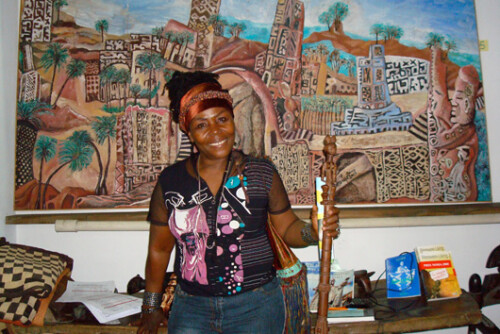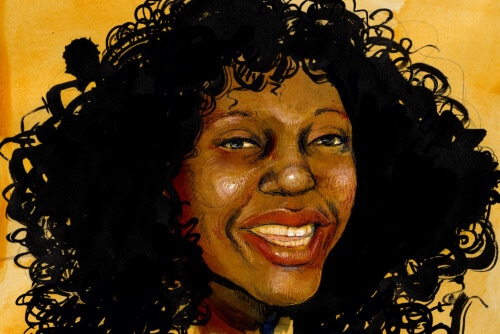My heritage informs both my artistic expressions and my worldview. And if I identify myself as Caribbean/Antillean, my world is a reflection of the complexity that comes from being a member of a crossroads culture, and the multi-cultural baggage that it entails. I strive to tell a story, without the urge to explain the plot or for the audience to ‘get it.’ I cherish the questions and the unexpected. I aim to give voice to an intense desire to create something new out of what is already perceived to be fact. I don’t try to recreate, but rather to ‘blend all the ingredients’ or influences, and make something new, something ‘Creole’ in its truest sense. This is where my work is most typically Caribbean. As a member of a ‘crossroads’ culture, I am constantly negotiating the links between tradition and modernity, realism and the supernatural, colonial and post-colonial. (Christa 2002, 302)
Film and history together beg for meaning and interpretation. I didn’t fully realize the ramifications of putting these stories up on screen. The added meaning inserted itself while filming and afterwards through the eyes of an audience; even I come away with many questions: How do I combine my urge to educate with my desire to make an artistic interpretation of history? How do I motivate viewers to do some of their own research (by visiting the Web site) after the film? How do I tell a visual story that remains open to interpretation? Can dance even tell the story I want to tell, or is it too ephemeral? I initially believed all of this was possible—that is why I took on this project. Yet I wonder: Do I need to provide more background information, or shall I leave the films as they are&mash;artistic interpretations?
Writing this essay about my film series (ANOTHER BUILIDING dancing), which places narrative dance in and around historical buildings from the Dutch-African Diaspora, proved difficult. Obviously, I thought about what I wanted for the films when I conceived of them; I talked about the meaning in several Q & A sessions after screenings; I wrote funding requests; I communicated my intentions to my collaborators (the costume designer, director of photography, composer, and editor). In all of these efforts to get the films going, nothing challenged me more than transferring the clarity I found in creating the films into writing. How could I, on paper, combine the many elements and sources of my work? How could I communicate my motivation? In what context could I place it? I hadn’t really thought through these issues until this point. After all, I made the films within one year, leaving little time for self-reflection.
On many levels, I just stumbled upon this series and felt right away that this is exactly who I am and what I am supposed to do. These films combine all that I am interested in—history, anthropology, dance, and architecture. When I found the series, I just ran with it: fast! Writing this essay, then, gives me the chance to step back and think about what I created. In doing so, I hope to show how personal history “motives” are inflected with and informed by larger post-colonial histories.
Thoughts, Goals, and Process
I set out to make each film in the series stand on its own as a work of art. Ideally, these pieces talk about the past without preaching. They also, I hope, spark an interest in investigating the past, leading young and older audiences to a website that provides background information on place, architecture, music, and dance.
I started the series with what I know best: the history of my native island Curaçao in the Netherlands Antilles. The first two films in the series, Quarantine and Savoneta, take place in Curaçao. The island was (and is) dry and unsuitable for plantation agriculture, but it grew to prominence because of its natural harbor, Willemstad, which enabled it to become a trade (smuggling) center and slave depot (Oostindie 2005, 3). It was during the occupation of Brazil (1624 to 1654) that the Dutch became involved in the slave trade and took interest in Curaçao.
In designing the shoot, I made a book full of images that gave a close impression of the look I wanted to achieve. And in creating the aesthetic, I juxtaposed the intense history of the place with the beauty of the landscape. Cinematographer Dolph van Stapele and I chose to use mostly a single handheld camera to create a more intimate feeling.
The sound includes live sounds and composed music, both of which I used to convey a sense of place (to create authenticity) and to make it contemporary. I chose my own music (mostly original music from the island) and also asked composer Vernon Reid to create a score that made it timeless and global but not connected to a particular place. In Quarantine, the main music is Tambu, a form of spoken social commentary (hailing from the 17th century) that has much in common with rap, which also shows up in the film.
For the choreography, I looked for dance that combined both old and new movements or referred in some way to the past. What I aimed to accomplish in Quarantine (and Savoneta) was to have the dance and story take place in the present time, looking back. The performers in both narratives are visitors to the place, and the confrontation with the history within and outside the walls triggers a journey through time. We witness what happens when they are confronted with the past, and as several narratives and viewpoints take place at once.
Quarantine
Situated on a hill overlooking the sea, the building in which Quarantine takes place originally housed (or quarantined) enslaved Africans who survived the trip from Africa but were too sick to continue on to other places. After their recovery, most traveled on to their final destination on one of the other islands—or to any part of the rest of the Americas.
At the start of the film, a young man visits the abandoned building, literally feeling the space by resting his head on the door. Through dance, he uses his body to possess the space, asking it to accept him. He communicates with the spirits of his ancestors in movement, wanting acceptance for his male/female dichotomy (he wears a skirt and dances). His dance combines white Western movements with contemporary black American (hip-hop) culture. During his dance, an elder observes the young man, who remains unaware of the onlooker’s presence. Perhaps the elder is the father—or is he an older version of the young man dancing, looking back on his life and wishing he could/did dance that freely? The subtext here is the issue of what a macho Caribbean/African male can and cannot do—dancing in skirts does not make the cut. At the end, however, we become aware that the old man, like the younger one, actually longs to dance freely in a skirt. Just when he shows signs of disapproval (by throwing the younger man a pair of pants), we find him wearing a skirt, dancing happily and finally liberated.
This context—that a man might long to dance freely—is based entirely on the story of my father, who plays the old man in the film. My dad passed on to me his love of dance, and he is on many levels a sensitive and feminine man—yet also very heterosexual. He always wanted to be a dancer but never became one because of his upbringing and society.
Throughout the film, the abandoned building triggers and empowers the growth of the two men. The history the young man feels by touching and becoming one with the building, and by confronting and possessing the building with his dance, comes to life for him.
I, too, believe (and feel) that life still exists inside those buildings.



![On [Not] Watching the Video](https://sfonline.barnard.edu/wp-content/uploads/2019/09/Seeds-of-Justice-COVER-1-e1571082420171-500x334.jpg)
